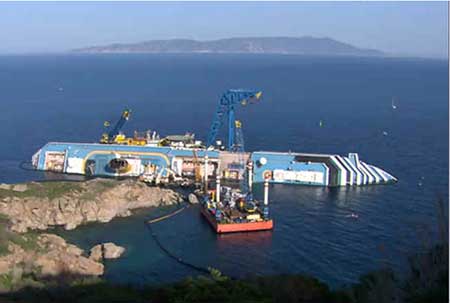Why Not Make the Costa Concordia a Diverís Paradise?Contents of this Issue: Blue Lagoon Resort, Chuuk, Micronesia Another Chuuk Option: the Truk Odyssey Flying to Micronesia? Options to Avoid United Belize Diving Services, Caye Caulker, Belize Bad Mistakes Dead Divers Make: Part II Why Not Make the Costa Concordia a Diverís Paradise? DEPP: Off the Recommended List Five Websites That Makes Dive Travel Easier ďAnotherĒ Recall for Aqua Lungís SureLock Weight Pockets A Bad Dive Weekend Coast to Coast Humans Have Changed Stingraysí Ways Editorial Office: Ben Davison Publisher and Editor Undercurrent 3020 Bridgeway, Suite 102 Sausalito, CA 94965 from the April, 2013 issue of Undercurrent
It was big news last year when the cruise ship Costa Concordia struck a rock off Italy's Mediterranean coast. It was the largest passenger wreck of all time, with 30 passenger deaths, and the wreck is still sitting, mostly submerged. Because the Costa Concordia is in a nationally protected marine park and coral reef, it must be removed from the area before it can be dismantled, posing countless difficulties. There's a salvage plan, but at $400 million (paid for by insurance companies), it's the most expensive, complicated and riskiest salvage operation ever to be undertaken - and no one is sure if it will work. The Costa Concordia is sitting on two underwater mountain peaks, with 65 percent of it below the surface. The plan is to rotate the ship upright and onto an underwater platform. Then it will float up, leaving more of its structure above the surface, and can be towed away. The platform, being built in northern Italy, then it must be transported around Italy's boot and up to the wreck. The steel, which weighs three times as much as the Eiffel Tower, will be embedded in the seafloor. It's a highly complex and expensive plan, involving welding a new ship, which will consist of huge, hollow steel boxes called sponsons, onto the shipwreck, connecting them to a metal platform, and using hydraulic platforms to pull the ship upright and make it float. The goal is to have it do so by next summer. 60 Minutes' Leslie Stahl recently did a report on the proposed operation -- view it at www.cbsnews.com/video/watch/?id=50137223n
|

I want to get all the stories! Tell me how I can become an Undercurrent Online Member and get online access to all the articles of Undercurrent as well as thousands of first hand reports on dive operations world-wide
| Home | Online Members Area | My Account |
Login
|
Join
|
| Travel Index |
Dive Resort & Liveaboard Reviews
|
Featured Reports
|
Recent
Issues
|
Back Issues
|
|
Dive Gear
Index
|
Health/Safety Index
|
Environment & Misc.
Index
|
Seasonal Planner
|
Blogs
|
Free Articles
|
Book Picks
|
News
|
|
Special Offers
|
RSS
|
FAQ
|
About Us
|
Contact Us
|
Links
|
3020 Bridgeway, Ste 102, Sausalito, Ca 94965
All rights reserved.

 But Undercurrent reader Nick Herbert, a former technical diver turned dive instructor and aircraft engineer
in Hong Kong, offers an alternative. "Surely a far less costly method -- and eventually more beneficial to the
local economy -- would be to empty the ship of all petroleum-based and other toxic fluids, where it lies. The
skilled commercial divers necessary for this process are already on site. After pumping out the liquid liabilities,
the next step would be to weld any narrow companionways
closed to seal off any remaining hazardous areas,
and cut large access holes in suitably (safer) areas of interest.
Then the ship is released and allowed to 'roll' down the
(already damaged) reef to the seabed. Once stabilized there,
a final check, et voila -- a 'new' wreck for sports divers to
visit. She'll become home to a vast array of local underwater
wildlife, thus eventually balancing most of the reef damage
already incurred. Local hotels and restaurants will prosper,
a dive shop will inevitably open in the area, and the whole
thing will cost a lot less than this $400 million proposal!"
But Undercurrent reader Nick Herbert, a former technical diver turned dive instructor and aircraft engineer
in Hong Kong, offers an alternative. "Surely a far less costly method -- and eventually more beneficial to the
local economy -- would be to empty the ship of all petroleum-based and other toxic fluids, where it lies. The
skilled commercial divers necessary for this process are already on site. After pumping out the liquid liabilities,
the next step would be to weld any narrow companionways
closed to seal off any remaining hazardous areas,
and cut large access holes in suitably (safer) areas of interest.
Then the ship is released and allowed to 'roll' down the
(already damaged) reef to the seabed. Once stabilized there,
a final check, et voila -- a 'new' wreck for sports divers to
visit. She'll become home to a vast array of local underwater
wildlife, thus eventually balancing most of the reef damage
already incurred. Local hotels and restaurants will prosper,
a dive shop will inevitably open in the area, and the whole
thing will cost a lot less than this $400 million proposal!"